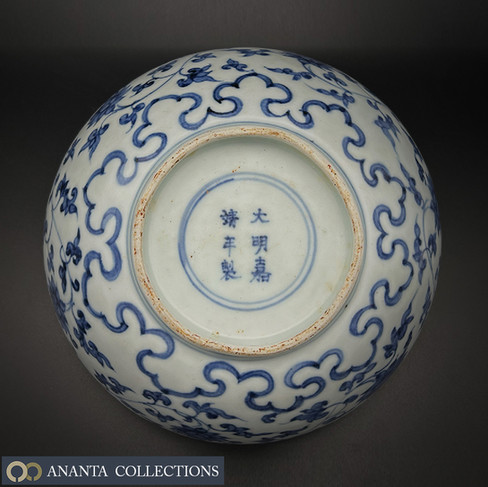Lotus scroll on Chinese blue and white porcelain from the Jiajing Era
- Artemis

- Dec 22, 2023
- 2 min read
Updated: Jan 25, 2024

Lotus flowers have long been important symbols in Chinese culture, both in Buddhism and folk religion. Lotus flowers represent enlightenment and purity because they can grow and bloom beautifully even in muddy water. This is often compared to a person who has achieved enlightenment and overcome all suffering.
The Chinese word "hé" (荷), which means "lotus flower," is also homophonous with the word "hé" (和), which means "harmony." This makes the lotus flower a popular auspicious motif that is often found on fine Chinese porcelain. Lotus flower motifs are often used in art forms such as porcelain, painting, sculpture, and architecture to represent auspicious meanings.
In addition to its religious and cultural meanings, the lotus flower also has philosophical meanings. Lotus flowers can be compared to human life, which grows and thrives in the midst of challenges and obstacles.
Examples of lotus flower motifs on Chinese porcelain include:
Lotus scroll: This is the most common motif and represents beauty and purity.
Lotus flower pairs: This motif represents couples or married couples.
Lotus flower triplets: This motif represents unity and harmony.
Lotus flower quintets: This motif represents good luck and prosperity.
This lotus scroll blue and white porcelain bowl is believed to have been produced in the late 16th century during the Ming dynasty, under the reign of Emperor Jiajing (1521-1580). This corresponds to the years 1548-1623 in the Buddhist Era. The bowl was found in Thailand and is likely one of the tribute bowls that Emperor Jiajing sent to the King of Siam at that time.
The lotus scroll motif on the bowl consists of six lotus flowers, each with a winding stem that connects them into a continuous curve around the bowl. The bottom edge of the bowl is decorated with a band of cloud or Yu-I motifs.
The lotus scroll motif on the bowl is beautifully executed. The outlines of the flowers are in deep blue, with thin blue washes applied over them. The glaze is thin and clear, with a faint blue tint. The lotus leaves are painted in a stylized manner, with long, pointed petals. Each lotus flower has a sense of depth and life.
The lotus scroll motif on the bowl has several auspicious meanings. First, the lotus flower is a symbol of enlightenment and purity for Buddhists. Second, the winding stems that connect the lotus flowers together symbolize unity and oneness. Third, the cloud or lingzhi motifs on the bottom edge of the bowl symbolize good luck and prosperity.
The bottom of the bowl bears six Chinese characters that read "Da Ming Jiajing Nianzhi," which means "Made in the Jiajing year of the Great Ming dynasty." This inscription confirms that the bowl was produced during the reign of Emperor Jiajing.
The bowl is in excellent condition, with a clean and polished surface. Based on the reign mark, it is dated to the late 16th century, during the reign of King Maha Chakkraphat (1548-1558), King Maha Thammaracha (1558-1559), or King Maha Thammarat (1559-1590).
This lotus scroll blue and white porcelain bowl is a valuable artifact that reflects the close cultural and diplomatic ties between China and Thailand. It is a beautiful and auspicious object that is sure to be admired for many years to come.












Comentários